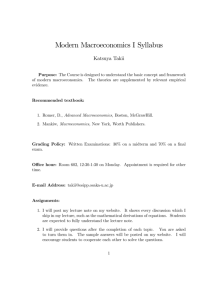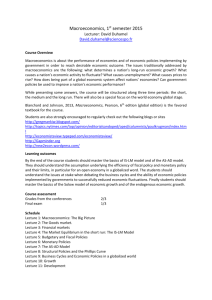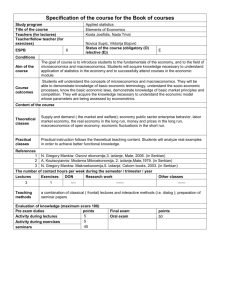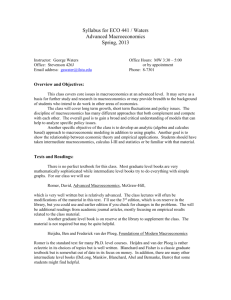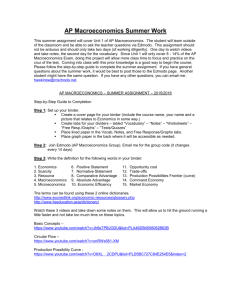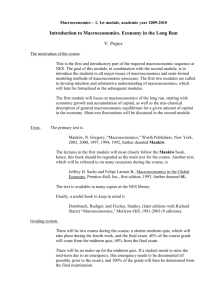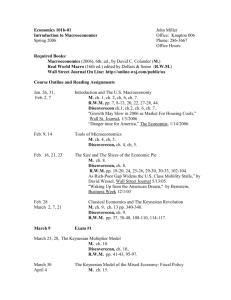Macroeconomics Finals
advertisement
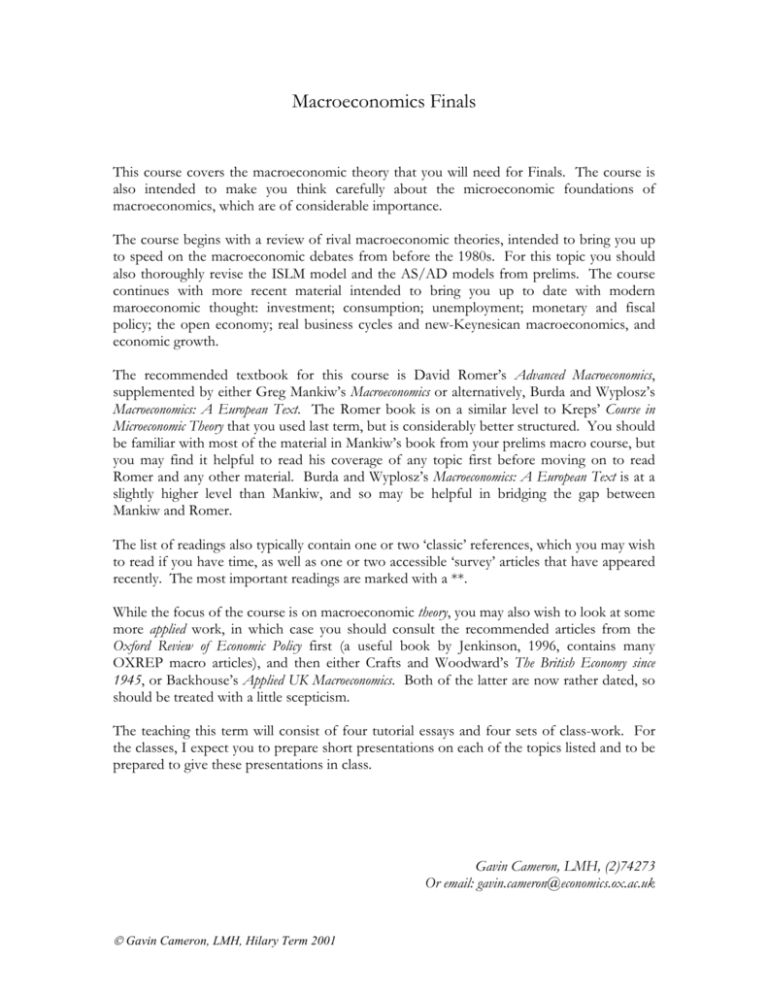
Macroeconomics Finals This course covers the macroeconomic theory that you will need for Finals. The course is also intended to make you think carefully about the microeconomic foundations of macroeconomics, which are of considerable importance. The course begins with a review of rival macroeconomic theories, intended to bring you up to speed on the macroeconomic debates from before the 1980s. For this topic you should also thoroughly revise the ISLM model and the AS/AD models from prelims. The course continues with more recent material intended to bring you up to date with modern maroeconomic thought: investment; consumption; unemployment; monetary and fiscal policy; the open economy; real business cycles and new-Keynesican macroeconomics, and economic growth. The recommended textbook for this course is David Romer’s Advanced Macroeconomics, supplemented by either Greg Mankiw’s Macroeconomics or alternatively, Burda and Wyplosz’s Macroeconomics: A European Text. The Romer book is on a similar level to Kreps’ Course in Microeconomic Theory that you used last term, but is considerably better structured. You should be familiar with most of the material in Mankiw’s book from your prelims macro course, but you may find it helpful to read his coverage of any topic first before moving on to read Romer and any other material. Burda and Wyplosz’s Macroeconomics: A European Text is at a slightly higher level than Mankiw, and so may be helpful in bridging the gap between Mankiw and Romer. The list of readings also typically contain one or two ‘classic’ references, which you may wish to read if you have time, as well as one or two accessible ‘survey’ articles that have appeared recently. The most important readings are marked with a **. While the focus of the course is on macroeconomic theory, you may also wish to look at some more applied work, in which case you should consult the recommended articles from the Oxford Review of Economic Policy first (a useful book by Jenkinson, 1996, contains many OXREP macro articles), and then either Crafts and Woodward’s The British Economy since 1945, or Backhouse’s Applied UK Macroeconomics. Both of the latter are now rather dated, so should be treated with a little scepticism. The teaching this term will consist of four tutorial essays and four sets of class-work. For the classes, I expect you to prepare short presentations on each of the topics listed and to be prepared to give these presentations in class. Gavin Cameron, LMH, (2)74273 Or email: gavin.cameron@economics.ox.ac.uk Gavin Cameron, LMH, Hilary Term 2001 RIVAL MACROECONOMIC THEORIES MACROECONOMICS FINALS 1. Reading This topic is designed to provide an outline of the major macroeconomic debates before the 1980s. The classic reference is of course Keynes (1936), but you should read Stevenson, Muscatelli and Gregory (1988) and Carlin and Soskice for more modern treatments (1990). Pierce and Tysome (1985) also provide a thorough monetary perspectice. Chapter 30 of Blanchard (1997) gives an enjoyable account of ‘The Story of Macroeconomics’. You should also thoroughly revise the material on the closed economy ISLM model and aggregate demand and aggregate supply from Romer (1996), and to a lesser extent, either Mankiw (1997) or Burda and Wyplosz (1997). Take notes on: i. ii. iii. iv. v. vi. vii. The Classical Dichotomy and the Neutrality of Money. The Keynesian view of aggregate demand. Effective demand, the consumption function, animal spirits, liquidity preference. The liquidity trap, interest-inelastic expenditure, and money wage rigidity. The real balance effect. The Neo-classical synthesis. The Japanese recession of the 1990s. 2. Essay Does Keynesian unemployment depend on the existence of nominal or real wage rigidity? (1998) 3. References Attfield, C., Demery, D. & Duck, N. (1985) Rational Expectations in Macroeconomics, Blackwell, Oxford, chapters 2 and 4. Blanchard, O. (1997) Macroeconomics, Prentice Hall, London, chapter 30. Burda, M and Wyplosz, C. (1997) Macroeconomics: A European Text, OUP, Oxford, chapters 10 & 11. **Carlin, W. and Soskice, D. (1990) Macroeconomics and the Wage Bargain, OUP, Oxford, chapters 1-5. Keynes, J. M. (1936) The General Theory of Employment, Interest and Money, Macmillan, London, chapters 1-3, 18-19. Mankiw, G. (1997) Macroeconomics, 3rd Edition, Worth Publishers, New York, chapters 8-10. Pierce, D. and Tysome, P. (1985) Monetary Economics, 2nd edition, Butterworths, London, chapters 5 & 6. **Romer, D. (1996) Advanced Macroeconomics, McGraw-Hill, New York, chapter 5. **Stevenson, A., Muscatelli, V. and Gregory, M. (1988) Macroeconomic Theory and Stabilisation Policy, Philip Allan, New York, chapters 1-4. Gavin Cameron, LMH, Hilary Term 2001 INVESTMENT MACROECONOMICS FINALS 1. Reading Investment is an important and volatile component of aggregate demand, as well as an important determinant of income per capita. Romer (1996) presents a readable introduction to this topic, see also Burda and Wyplosz (1997) and Mankiw (1997) for background material. Begg (1982) discusses the application of rational expectations to investment. Another interesting paper is Dixit (1992). Hay and Morris (1991) provide an industrial economics view of the issue. You may also wish to look at the articles in the Oxford Review of Economic Policy issue of Summer 1996, especially Bond and Jenkinson. Backhouse (1991) discusses the UK experience. Take notes on: i. ii. iii. iv. vi. vii. Marginal Productivity of Capital and the Optimal Capital Stock. The Accelerator. Tobin’s q. The effect of permanent and temporary changes in output and cash flow on investment. The effect of permanent and temporary changes in interest rates and taxes on investment. Investment and irreversibility. How does the investment rate in the UK compare with other advanced economies? 2. Class-work v. Prepare a short presentation on each of the above topics and be prepared to give the presentation in the class. 3. References Backhouse, R. (1991) Applied UK Macroeconomics, Blackwell, Oxford, chapter 3. **Begg, D. (1982) The Rational Expectations Revolution in Macroeconomics, Philip Allan, New York, chapter 7. Bond, S. and Jenkinson, T. (1996) ‘The assessment: investment performance and policy’, Oxford Review of Economic Policy. Burda, M and Wyplosz, C. (1997) Macroeconomics: A European Text, OUP, Oxford, chapter 4. **Dixit, A. (1992) ‘Investment and hysteresis’, Journal of Economic Perspectives. Hay, D. and Morris, D. (1991) Industrial Economics and Organization, 2nd edition, OUP, Oxford, chapters 11 & 12 Mankiw, G. (1997) Macroeconomics, 3rd Edition, Worth Publishers, New York, chapter 17. **Romer, D. (1996) Advanced Macroeconomics, McGraw-Hill, New York, chapter 8. Gavin Cameron, LMH, Hilary Term 2001 CONSUMPTION MACROECONOMICS FINALS 1. Reading This topic is a good example of the way that macroeconomic thinking has changed since the late 1970s. Until then, the life-cycle hypothesis and permanent-income hypothesis were dominant. After the inflationary shocks of the 1970s, Hall (1978) applied the theory of rational expectations to consumption, and produced the Rational Expectations Permanent Income Hypothesis (REPIH). However, this theory suffers from a number of empirical problems (notably, excess smoothness and excess sensitivity, as discussed in Deaton, 1992). Romer (1996) presents a readable introduction to this topic, see also Burda and Wyplosz (1997) and Mankiw (1997) for background material. You are strongly recommended to read Muellbauer (1994). Attfield, Demery, and Duck (1985) and Begg (1982) look at the impact of rational expectations on consumption. You may also wish to look at the articles in the Oxford Review of Economic Policy issue of Summer 1994. Backhouse (1991) outlines some other UK evidence. Take notes on: i. iii. iv. v. vi. vii. The Life-Cycle Hypothesis and the Permanent-Income Hypothesis. Consumption under uncertainty and the REPIH. The Euler Equation With Quadratic Preferences. Excess smoothness and excess sensitivity. The interest rate and saving. The effect on consumption of precautionary saving, credit constraints & asset prices. The UK saving rate in the 1980s. 2. Essay ii. Can any single theory of consumption behaviour account for all of the major movements of the personal savings to income ratio in the past 30 years? (1996) 3. References Attfield, C., Demery, D. & Duck, N. (1985) Rational Expectations in Macroeconomics, Blackwell, Oxford, chapter 9. **Attanasio & Weber (1994) ‘The UK consumption boom of the late 1980s - aggregate implications of microeconomic evidence’, Economic Journal, 104, pp. 1269-1302 Backhouse, R. (1991) Applied UK Macroeconomics, Blackwell, Oxford, chapter 2. Begg, D. (1982) The Rational Expectations Revolution in Macroeconomics, Philip Allan, New York, chapter 7. Burda, M and Wyplosz, C. (1997) Macroeconomics: A European Text, OUP, Oxford, chapter 4. Deaton, A. (1992) Understanding Consumption, OUP, Oxford, chapters 1-4. Hall, R. (1978) ‘Stochastic Implications of the Life Cycle-Permanent Income Hypothesis- theory and implications’, Journal of Political Economy, pp. 971-87. Mankiw, G. (1997) Macroeconomics, 3rd Edition, Worth Publishers, New York, chapter 15. **Muellbauer, J. (1994) ‘Consumer Expenditure’ in Oxford Review of Economic Policy, reprinted in Jenkinson, T. (1996) Readings in Macroeconomics, OUP, Oxford, chapter 7. **Romer, D. (1996) Advanced Macroeconomics, McGraw-Hill, New York, chapter 7. Gavin Cameron, LMH, Hilary Term 2001 UNEMPLOYMENT AND THE LABOUR MARKET MACROECONOMICS FINALS 1. Reading Unemployment is a major preoccupation of most governments. Romer (1996) presents a readable introduction to this topic, see also Burda and Wyplosz (1997) and Mankiw (1997) for background material. Layard, Nickell, and Jackman (1991) is the most important reference on this topic, along with Nickell (1997 and 1998). Carlin and Soskice (1990) is a very accessible account of the differences between the NAIRU and the NRU. Crafts and Woodward (1991) and Backhouse (1991) provide a UK historical perspective. You may also wish to look at the articles in the Oxford Review of Economic Policy issue of Spring 1995. Take notes on: i. ii. iii. iv. v. vi. vii. The Natural Rate of Unemployment. The NAIRU. Efficiency Wages. Hysteresis. Insiders and Outsiders. Real Wage Rigidity, Nominal Wage Rigidity and Nominal Inertia. What has happened to UK unemployment since the first oil shock? 2. Class-work Prepare a short presentation on each of the above topics and be prepared to give the presentation in the class. 3. References Backhouse, R. (1991) Applied UK Macroeconomics, Blackwell, Oxford, chapters 7 & 8. Burda, M and Wyplosz, C. (1997) Macroeconomics: A European Text, OUP, Oxford, chapter 6. **Carlin, W. and Soskice, D. (1990) Macroeconomics and the Wage Bargain, OUP, Oxford, chapter 6. Crafts, N. and Woodward, N. (1991) The British Economy Since 1945, OUP, Oxford, chapters 6 & 7. **Layard, R., Nickell, S. and Jackman, R. (1991) Unemployment, OUP, Oxford, chapter 1. Mankiw, G. (1997) Macroeconomics, 3rd Edition, Worth Publishers, New York, chapter 5. Nickell, S. (1997) ‘Unemployment and Labour Market Rigidities’, Journal of Economic Perspectives, pp. 55-74. Nickell, S. (1998) ‘Unemployment: Questions and Some Answers?’, Economic Journal, pp. 802-816. **Romer, D. (1996) Advanced Macroeconomics, McGraw-Hill, New York, chapter 10. Gavin Cameron, LMH, Hilary Term 2001 MONETARY AND FISCAL POLICY MACROECONOMICS FINALS 1. Reading Economists’ views on the effectiveness of monetary and fiscal policy have changed significantly since the 1970s. Although most economists accept that there is no long-run trade-off between unemployment and inflation, they do believe that there can be a short-run trade-off. Romer (1996) presents a readable introduction to this topic, see also Burda and Wyplosz (1997) and Mankiw (1997) for background material. Blinder and Solow (1973), Barro (1974), and Barro and Gordon (1983) are three ‘classic’ articles on macroeconomic policy. Attfield, Demery and Duck (1985) and Begg (1982) discuss rational expectations at length. Pierce and Tysome (1985) is a good summary of monetary policy issues, and like Crafts and Woodward (1991) and Backhouse (1991), provides a UK historical perspective. Take notes on: i. ii. iii. iv. v. vi. vii. The Phillips Curve and the Expectations-Augmented Phillips Curve. Adaptive and Rational Expectations. The Lucas Surprise Supply Model and the invariance proposition. The Lucas Critique. Ricardian Equivalence. Time Inconsistency and Central Bank Independence. British Monetary Policy since 1945. 2. Essay ‘The inflation target should be set at zero.’ Discuss. (1999) 3. References **Attfield, C., Demery, D. & Duck, N. (1985) Rational Expectations in Macroeconomics, Blackwell, Oxford, chapter 3. Backhouse, R. (1991) Applied UK Macroeconomics, Blackwell, Oxford, chapter 4 & 10. Barro, R. and Gordon, D. (1983) ‘Rules, Discretion, and Reputation in a Model of Monetary Policy’, Journal of Monetary Economics, pp. 101121. Barro, R. (1974) ‘Are Government Bonds Net Wealth?’, Journal of Political Economy. Blinder, A. and Solow, R. (1973) ‘Does Fiscal Policy Matter?’, Journal of Political Economy. Burda, M and Wyplosz, C. (1997) Macroeconomics: A European Text, OUP, Oxford, chapters 8,9, 15 & 16. Crafts, N. and Woodward, N. (1991) The British Economy Since 1945, OUP, Oxford, chapters 3 & 4. Gibbons, R. (1992) A Primer in Game Theory, Harvester-Wheatsheaf, New York, chapter 2. Mankiw, G. (1997) Macroeconomics, 3rd Edition, Worth Publishers, New York, chapters 8-10 and 16. **Pierce, D. and Tysome, P. (1985) Monetary Economics, 2nd edition, Butterworths, London, chapters 1 & 2. **Romer, D. (1996) Advanced Macroeconomics, McGraw-Hill, New York, chapter 9. Stevenson, A., Muscatelli, V. and Gregory, M. (1988) Macroeconomic Theory and Stabilisation Policy, Philip Allan, New York, chapters 5 & 6. Gavin Cameron, LMH, Hilary Term 2001 THE OPEN ECONOMY MACROECONOMICS FINALS 1. Reading When considering the exchange rate, governments must choose which two of the following trinity they prefer: independence of monetary policy, freedom from exchange controls, and a stable exchange rate. This issue is of great policy relevance given that Economic and Monetary Union begins on 1st January 1999. Krugman (1989) provides an enjoyable introduction to this issue, with Burda and Wyplosz (1997) and Mankiw (1997) providing the basic material. Krugman and Obstfeld (1997) cover the topic thoroughly. Pierce and Tysome (1985) give a nice overview of older material. Taylor (1995) provides a good review of exchange rate theory, which may be of interest as further reading. The Autumn 1998 issue of OXREP contains a number of articles on EMU, including a good piece on institutions by Maclennan, Muellbauer and Stephens. Crafts and Woodward (1991) and Backhouse (1991) provide a UK historical perspective. Take notes on: i. ii. iii. iv. v. vi. vii. The nominal and real exchange rate, the terms of trade. Domestic Absorbtion and The Balance of Payments. Devaluation, the Marshall-Lerner Condition, and the J-Curve. Purchasing Power Parity and Interest Parity. The Overshooting Model. Fundamental Equilibrium Exchange Rates and Target Zones. The case for, and against, EMU. 2. Class-work Prepare a short presentation on each of the above topics and be prepared to give the presentation in the class. 3. References Backhouse, R. (1991) Applied UK Macroeconomics, Blackwell, Oxford, chapter 11. Burda, M and Wyplosz, C. (1997) Macroeconomics: A European Text, OUP, Oxford, chapters 7 & 18-21 . Crafts, N. and Woodward, N. (1991) The British Economy Since 1945, OUP, Oxford, chapter 5. Dornbusch, R. (1976) ‘Expectations and Exchange Rate Dynamics’, Journal of Political Economy, pp. 1161-1176. Krugman, P. (1989) ‘The case for stabilizing exchange rates’ in Oxford Review of Economic Policy, reprinted in Jenkinson, T. (1996) Readings in Macroeconomics, OUP, Oxford, chapter 5. **Krugman, P. and Obstfeld, M. (1997) International Economics: Theory and Policy, 4th edition, Addison Wesley, New York, chapters 12 - 15. Mankiw, G. (1997) Macroeconomics, 3rd Edition, Worth Publishers, New York, chapter 7 & 11. **Maclennan, D., Muellbauer, J. and Stephens, M. (1998) ‘Asymmetries in housing and financial market institutions and EMU’, Oxford Review of Economic Policy, pp. 54-80. Pierce, D. and Tysome, P. (1985) Monetary Economics, 2nd edition, Butterworths, London, chapter 10. **Taylor, M. (1995) ‘The Economics of Exchange Rates’, Journal of Economic Literature, pp. 13-47. Gavin Cameron, LMH, Hilary Term 2001 REAL BUSINESS CYCLES AND NEW-KEYNESIAN MACRO MACROECONOMICS FINALS 1. Reading In this topic, we draw together many of the strands of thought from earlier in the term. After the rational expectations revolution, macroeconomic thought has developed two main research agenda. The first, real business cycle theory, uses rational expectations models to explain why serially-correlated shocks to the supply-side of the economy can generate business cycles. The second, new Keynesian macroeconomics, uses models with nominal rigidities to explain why business cycles can occur even in the presence of rational agents. Your essay should discuss these views and adjudicate between them. For RBC models, first, you should read Mankiw (1997), which provides a very clear non-technical introduction. Then, Muellbauer (1997) provides a comprehensive and sceptical review of RBC models, Stadler (1994) and Romer (1996) are also interesting. You may also wish to look at the articles in the Oxford Review of Economic Policy issue of Autumn 1997. A good introduction to New-Keynesian models is provided by the introduction to the Mankiw and Romer (1991) book, which also contains reprints of important papers by Mankiw (1985), Fischer (1977), Yellen (1984) and Blanchard and Summers (1987). Take notes on: i. Staggered wage contracts. ii. Menu costs. iii. Coordination Failures. iv. Efficiency wages. v. Sources of Real Shocks vi. Propagation Mechanisms. vii. US Productivity and Consumption Growth in the 1990s. 2. Essay ‘UK business cycles are best explained by a combination of errors and shocks.’ Do you agree? (1998) 3. References Blanchard, O. and Summers, L. (1987) ‘Hysteresis in Unemployment’, European Economic Review, pp. 288-295, reprinted in Mankiw, G. and Romer, D. (1991) New Keynesian Economics, MIT, Cambridge, vol. 2. Burda, M and Wyplosz, C. (1997) Macroeconomics: A European Text, OUP, Oxford, chapter 14. Fischer, S. (1977) ‘Long-Term Contracts, Rational Expectations, and the Optimal Money Supply Rule’, Journal of Political Economy, pp. 191205, reprinted in Mankiw, G. and Romer, D. (1991) New Keynesian Economics, MIT, Cambridge, vol. 1, chapter 7. Mankiw, G. (1997) Macroeconomics, 3rd Edition, Worth Publishers, New York, chapter 14. Mankiw, G. (1985) ‘Small Menu Costs and Large Business Cycles: A Macroeconomic Model of Monopoly’, Quarterly Journal of Economics, pp. 529-539, reprinted in Mankiw, G. and Romer, D. (1991) New Keynesian Economics, MIT, Cambridge, vol. 1, chapter 1. **Mankiw, G. and Romer, D. (1991) ‘Introduction’ , in Mankiw, G. and Romer, D. (1991) New Keynesian Economics, MIT, Cambridge, vol 1. Mankiw, G. (1997) Macroeconomics, 3rd Edition, Worth Publishers, New York, chapter 14. **Muellbauer, J. (1997) ‘The Assessment: Business Cycles’ in Oxford Review of Economic Policy, pp. 219-235. Stadler, G. (1994) ‘Real Business Cycles’, Journal of Economic Literature, pp. 1750-1783. **Romer, D. (1996) Advanced Macroeconomics, McGraw-Hill, New York, chapters 4 & 6. Yellen, J. (1984) ‘Efficiency-Wage Models of Unemployment’, American Economic Review, pp. 200-205, reprinted in Mankiw, G. and Romer, D. (1991) New Keynesian Economics, MIT, Cambridge, vol. 2, chapter 21. Gavin Cameron, LMH, Hilary Term 2001 ECONOMIC GROWTH MACROECONOMICS FINALS 1. Reading An understanding of economic growth is now a central part of the macroeconomics syllabus. Romer (1996) presents a readable introduction to this topic, see also Burda and Wyplosz (1997) and Mankiw (1997) for background material. The classic reference is Solow (1957) but this material is also covered in Solow (1988). Since Romer (1986), attention has focussed on endogenous growth. The most accessible and interesting discussions are in Jones (1998 and 1999) and Temple (1999). Mankiw (1995) provides an alternative view and suggests that exogenous growth may be able to explain many growth phenomena. You may also wish to look at the articles in the Oxford Review of Economic Policy issue of Summer 1996. Crafts and Woodward (1991) and Backhouse (1991) provide a UK historical perspective. Take notes on: i. ii. iii. iv. v. vi. vii. The Solow model, absolute and conditional convergence. The effect of saving on growth in the Solow model. The AK model. The effect of saving on growth in the AK model. The sources of endogenous growth. Scale vs non-scale models of growth. Policies to raise productivity growth in the UK. 2. Class-work Prepare a short presentation on each of the above topics and be prepared to give the presentation in the class. 3. References Backhouse, R. (1991) Applied UK Macroeconomics, Blackwell, Oxford, chapter 6. Blanchard, O. (1997) Macroeconomics, Prentice Hall, London, chapters 22-24. Burda, M and Wyplosz, C. (1997) Macroeconomics: A European Text, OUP, Oxford, chapter 5. Crafts, N. and Woodward, N. (1991) The British Economy Since 1945, OUP, Oxford, chapter 9. **Jones, C. (1998) Introduction to Economic Growth, Norton, New York, chapters 2,5 & 8. **Jones, C. (1999) "Growth: With or Without Scale Effects?" American Economic Review Papers and Proceedings, 89, 139-144. Mankiw, G. (1995) ‘The Growth of Nations’, Brookings Papers on Economic Activity, pp. 275-301. Mankiw, G. (1997) Macroeconomics, 3rd Edition, Worth Publishers, New York, chapter 4. Romer, P. (1986) ‘Increasing Returns and Long Run Growth’, Journal of Political Economy, pp. 1002-37. **Romer, D. (1996) Advanced Macroeconomics, McGraw-Hill, New York, chapters 1 & 3. Solow, R. (1957) ‘Technical Change and the Aggregate Production Function’, Review of Economics and Statistics, pp. 312-20. Solow, R. (1988) Growth Theory: An Exposition, OUP, Oxford. Temple, J. (1999) ‘The new growth evidence’, Journal of Economic Literature, pp. 112-156. Gavin Cameron, LMH, Hilary Term 2001


